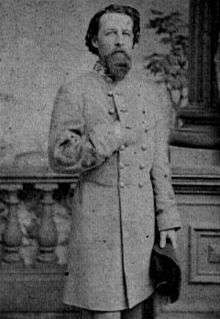John Rogers Cooke
| John Rogers Cooke | |
|---|---|
 | |
| Born |
June 9, 1833 Jefferson Barracks, Missouri |
| Died |
April 10, 1891 (aged 57) Richmond, Virginia |
| Place of burial | Hollywood Cemetery, Richmond, Virginia |
| Allegiance |
|
| Service/branch |
|
| Years of service |
1855–1861 (USA) 1861–1865 (CSA) |
| Rank |
|
| Battles/wars | |
John Rogers Cooke (June 9, 1833 – April 10, 1891) was a Confederate general during the American Civil War. He was the son of Union general Philip St. George Cooke and the brother-in-law of Confederate cavalry leader Jeb Stuart.
Biography
The son of a career army officer, Cooke was born at Jefferson Barracks, Missouri. After studying at the University of Missouri and Harvard College, Cooke was commissioned into the United States Army in 1855 as a second lieutenant of the 8th U.S. Infantry Regiment.[1] On January 28, 1861, Cooke was promoted to second lieutenant.[1] When Virginia seceded from the Union, in 1861 Cooke followed his brother-in-law, Jeb Stuart, south. To his dismay, his father remained loyal to the Union.[2]
Civil War
In 1861, Cooke was commissioned a first lieutenant in the Confederate Army, and participated in the First Battle of Bull Run. In April 1862, he was elected colonel of the 27th North Carolina Infantry. Although wounded at the Battle of Antietam, he was able to keep the field and was promoted to brigadier general on November 1, 1862.[2]
Leading a brigade in action at the Battle of Fredericksburg, Cooke was badly wounded when a bullet entered over his left eye and fractured his skull. He was able to return to the field in April 1863. In October 1863, while commanding a brigade in A.P. Hill's corps, Cooke was again seriously wounded at the Battle of Bristoe Station during Hill's attack on the Union II Corps. His shinbone was shattered and he was knocked out of action for some time. He passed the time by serving on courts of inquiry in Richmond. Cooke returned to duty but was once again wounded in the leg at the Battle of Spotsylvania, but remained on the field to lead an assault on horseback. Cooke was wounded seven times during the Civil War.[2]
Post-War life
When the War ended, Cooke went to Richmond, and became a merchant. He was an active member of the community and was one of the founders of the Confederate Soldiers' Home in Richmond. The family breach with his father—who had stayed loyal to the Union—was healed some time after the end of the War. Cooke died in Richmond, Virginia and is buried there in Hollywood Cemetery.[2]
See also
Notes
- 1 2 Eicher, John H., and David J. Eicher, Civil War High Commands. Stanford: Stanford University Press, 2001. ISBN 0-8047-3641-3. p. 183
- 1 2 3 4 And Then A.P. Hill Came Up - Biography of John R. Cooke
References
- Eicher, John H., and David J. Eicher, Civil War High Commands. Stanford: Stanford University Press, 2001. ISBN 978-0-8047-3641-1.
- Sifakis, Stewart. Who Was Who in the Civil War. New York: Facts On File, 1988. ISBN 978-0-8160-1055-4.
- Warner, Ezra J. Generals in Gray: Lives of the Confederate Commanders. Baton Rouge: Louisiana State University Press, 1959. ISBN 978-0-8071-0823-9.
- And Then A.P. Hill Came Up- Biography of John Rogers Cooke